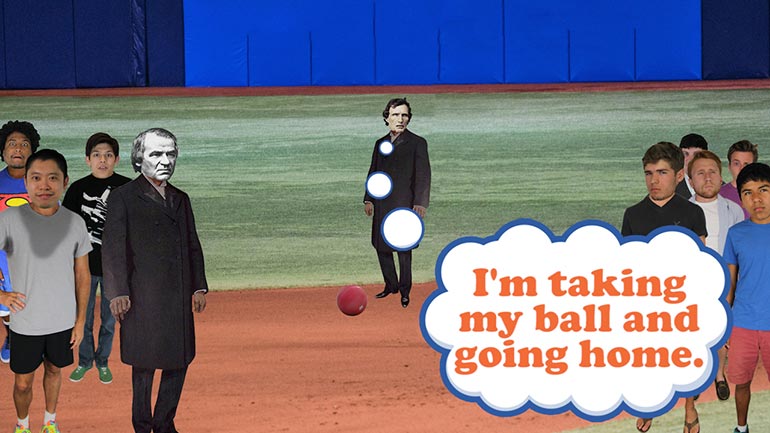ShmoopTube
Where Monty Python meets your 10th grade teacher.
Search Thousands of Shmoop Videos
Math 5: Dividing Fractions to Determine Business Growth or Loss 13 Views
Share It!
Description:
“But when will I ever use math in real life?” you ask. Here. Literally right here. You’re welcome.
Transcript
- 00:02
[Dino and Coop singing]
- 00:12
So you know how to divide fractions…congratulations! [Confetti falls on student]
- 00:15
But will this new skill do you any good in the rough-and-tumble world of business, where
- 00:20
people are more interested in making loads of money by any means necessary… [People looking angry and holding up money and notepads]
- 00:24
…rather than sitting around, quietly doing math?
Full Transcript
- 00:27
Well…yeah, actually.
- 00:28
This kind of math's really important in business. [Students walks across classroom yelling and holding math workings]
- 00:30
After all, yelling angrily will only get you so far.
- 00:33
To see how this works, let's take a look at a couple of examples.
- 00:35
Kim's an accountant at a toy company, but just because there are toys all over the place
- 00:39
doesn't mean that her work's all fun and games. [Kim is knocked over by an RC car]
- 00:41
Right now, she's in a bit of a pickle.
- 00:43
She's looking over the files for their sled division, and appropriately enough, profits [Kim's body is replaced by a pickle]
- 00:48
are going downhill.
- 00:49
She knows that over the last two years, profits have decreased by a total of four fifths.
- 00:54
But she can't find the records that tell her how much profits fell each year.
- 00:58
If she knows that each year's profits decreased by an equal value relative to where profits [Kim thinking about the problem]
- 01:04
were two years ago, by how much did profits decrease each year?
- 01:08
She could spend the next few days rifling through the company's basement, trying to [Kim looking through filing cabinets]
- 01:12
find the missing information...
- 01:13
Or she could just do some math.
- 01:15
We vote math.
- 01:16
Less chance of running into mice and dust bunnies. [Kim's face turns green]
- 01:19
Since the profits decreased by the same amount relative to where profits were the first
- 01:23
year, we can take the total drop, of four fifths…
- 01:26
…and divide it by two, for each of the two years that passed.
- 01:29
Luckily we know a thing or two about dividing fractions, so we multiply four fifths by the
- 01:33
reciprocal of two, one half…
- 01:36
…which gives us four tenths.
- 01:39
And once we divide the common factor of two out of the numerator and the denominator… [Fraction workings on a whiteboard]
- 01:44
…we're left with our final answer: two fifths.
- 01:47
It might have taken a few steps, but it was a lot quicker than a few hours in the basement.
- 01:51
And a lot less dusty, too. [Kim sneezes and a big dust cloud appears]
- 01:52
It turns out Kim has some more incomplete data to wrestle with.
- 01:56
Over the last three years, the jack-in-the-box division saw their profits go up seven eighths.
- 02:01
Again, though, there are some gaps in her data. [Arrows point to gaps in the graph]
- 02:04
If she knows that each year's profits increased by an equal value relative to where profits
- 02:09
were three years ago, by how much did profits increase each year?
- 02:13
Unfortunately, she's unlikely to find the answer in a jack-in-the-box. [Kim winds the handle on the box]
- 02:17
Well, unless the answer is: "a creepy clown face." [A clown jumps out the box and scares Kim]
- 02:21
Time for more fraction division.
- 02:24
Since the profits increased by the same amount relative to where profits were that first
- 02:29
year, we can take the total increase, of seven eighths…
- 02:31
…and divide it by three, for each of the three years that passed.
- 02:35
So we multiply seven eighths by the reciprocal of three, one third…
- 02:38
…which gives us seven twenty-fourths.
- 02:41
With no common factors, we're done! [The missing data is written on the chart]
- 02:43
And bonus: no one got a crippling fear of clowns that hide in boxes. [Kim chucks the Jack-in-the-box away and it explodes]
Up Next
Check out the best bias video ever made, courtesy of the most awesome and amazing educational website in existence.
Related Videos
No, this isn't a terrible new mint-peach bubble gum flavor...though it does tend to leave a bad taste in people's mouths.
Those settlers in Jamestown really should have settled down with all that land-stealing. Tobacco's bad for you anyway.
Being born out of multiple wars doesn't quite seem to fit the peaceful, polite Canadians we know and love today...oh wait, they were called The Bea...
Not every cartoon is meant to entertain small children while their mother gets some "Mommy time." There are also political cartoons, which are mean...




